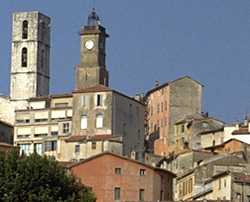

.../...
Grasse, the perfume capital of the world, is a gateway town to Beyond. To the south, only 15 km away, is the city of Cannes with its yachts, fine-sand beaches and luxury shopping. To the east, about a 30-minute drive away, is Nice, with its international airport, pebble beaches and the bustle of a busy city. Turning inland from Grasse, at zero distance, you have the hills and forests and canyons and rivers of Beyond.
Grasse has been a popular tourist town for several centuries, with the smell of flowers and clear air. The altitude of the town, from 300-400 m, and the hills behind give Grasse a fresher climate than the beach during the heat of the summer. Princess Pauline Bonaparte, the Emperor's sister, spent the winter of 1807-08 in Grasse, recuperating her mental and physical strength. Queen Victoria vacationed through several winters in Grasse, staying at the Rothschild's or at the Grand Hotel. Napoléon himself passed through Grasse on 2 March 1815, but didn't have time for vacationing.
The old town ("vieille ville") is large, old, and extremely interesting. Tiny streets wind forever between the 17th and 18th century buildings, up and down ancient steps, passing through arched tunnels and sometimes opening out onto large squares.
The principal square near the top of the old town is the Place aux Aires, with a daily market of flowers and regional foods. A pretty, three-tiered fountain splashes in the center of the flowers, and arcades line one long side.
Somewhere down in the old village a narrow street comes out onto the Place Godeau, with the 10-11th-century Notre Dame du Puy cathedral (rebuilt in the 17th c.) and its huge 18th century clock tower. Inside the cathedral are three paintings by Rubens, commissioned from the then-unknown artist in 1601 by the Archduke Albert for the Santa Croce di Gerusalemme in Rome, and offered to Grasse in the 19th century. There's also the 1754 painting Christ Washing the Feet of the Apostles by Jean-Honoré Fragonard.
Also in the Place Godeau is 12th-century "Tour de Guet" (watch tower) at the Mairie, which was the Bishop's Palace.
